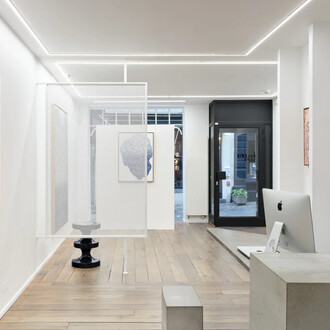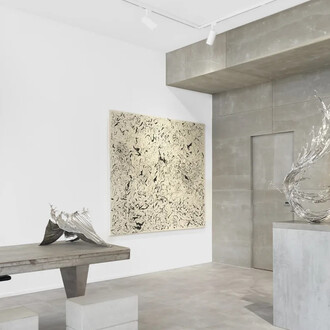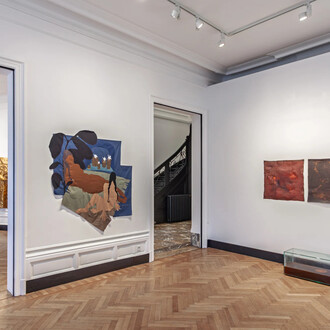White on white brings together three contemporary artists—Katrin Fridriks, Joan Saló, and Zheng Lu—who approach the color white not as a void, but as a force. In their hands, white is neither neutral nor passive. It becomes gesture, structure, rhythm, and reflection—a visual field where clarity meets complexity, and absence becomes a site of transformation.
For Icelandic artist Katrin Fridriks, white is an elemental force—charged with energy, speed, and motion. Her compositions emerge from physical intuition and technical control, where paint is launched across the surface in spontaneous, gravitational arcs. Echoing the drama of natural phenomena—glaciers cracking, geysers erupting—Fridriks channels the invisible power of nature into painterly explosions. White here is not serenity, but saturation: a flash of intensity suspended in time.
By contrast, Joan Saló navigates white as a space of repetition and rhythm. His paintings, built from thousands of hand-drawn lines using ink and acrylic, unfold like woven fields of thought. There is a strong kinship to minimalism and to Agnes Martin’s meditative grids, yet Saló’s visual language feels closer to calligraphy and automatic writing. He builds volume through nuance, structure through fragility. White becomes a zone of introspection—an intimate landscape mapped through gesture and restraint.
With Zheng Lu, white takes on sculptural dimension. Cast in stainless steel but shaped to evoke the liquidity of water, his sculptures freeze motion into mirrored form. Light dances across their surfaces, exposing layers of reflection, both literal and symbolic. Drawing from traditional Chinese calligraphy and contemporary fluid dynamics, Zheng’s work bridges material with metaphor. White in his work is both the shimmer of light and the silence of form—ephemeral yet enduring.
Though formally distinct, these three practices converge in their devotion to process, perception, and presence. From the volcanic intensity of Fridriks to the ink-soaked patience of Saló and the fluid monumentality of Zheng, the exhibition reclaims white as an active site of becoming. Echoing Malevich’s radical proposal of the blank canvas as infinite potential, White on white invites us to slow down, to look closer, and to rediscover meaning in the minimal.
Not absence—but emergence. Not silence—but resonance.
















